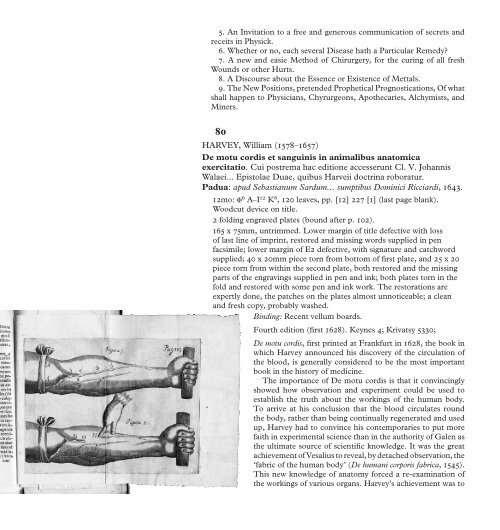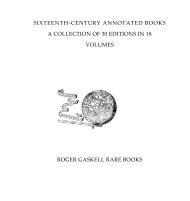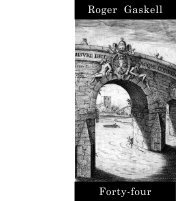pdf - Roger Gaskell Rare Books
pdf - Roger Gaskell Rare Books
pdf - Roger Gaskell Rare Books
You also want an ePaper? Increase the reach of your titles
YUMPU automatically turns print PDFs into web optimized ePapers that Google loves.
5. An Invitation to a free and generous communication of secrets and<br />
receits in Physick.<br />
6. Whether or no, each several Disease hath a Particular Remedy?<br />
7. A new and easie Method of Chirurgery, for the curing of all fresh<br />
Wounds or other Hurts.<br />
8. A Discourse about the Essence or Existence of Mettals.<br />
9. The New Positions, pretended Prophetical Prognostications, Of what<br />
shall happen to Physicians, Chyrurgeons, Apothecaries, Alchymists, and<br />
Miners.<br />
80<br />
HARVEY, William (1578–1657)<br />
De motu cordis et sanguinis in animalibus anatomica<br />
exercitatio. Cui postrema hac editione accesserunt Cl. V. Johannis<br />
Walaei... Epistolae Duae, quibus Harveii doctrina roboratur.<br />
Padua: apud Sebastianum Sardum... sumptibus Dominici Ricciardi, 1643.<br />
12mo: ✠6 A–I12 K6 , 120 leaves, pp. [12] 227 [1] (last page blank).<br />
Woodcut device on title.<br />
2 folding engraved plates (bound after p. 102).<br />
165 x 75mm, untrimmed. Lower margin of title defective with loss<br />
of last line of imprint, restored and missing words supplied in pen<br />
facsimile; lower margin of E2 defective, with signature and catchword<br />
supplied; 40 x 20mm piece torn from bottom of Wrst plate, and 25 x 20<br />
piece torn from within the second plate, both restored and the missing<br />
parts of the engravings supplied in pen and ink; both plates torn in the<br />
fold and restored with some pen and ink work. The restorations are<br />
expertly done, the patches on the plates almost unnoticeable; a clean<br />
and fresh copy, probably washed.<br />
Binding: Recent vellum boards.<br />
Fourth edition (Wrst 1628). Keynes 4; Krivatsy 5330;<br />
De motu cordis, Wrst printed at Frankfurt in 1628, the book in<br />
which Harvey announced his discovery of the circulation of<br />
the blood, is generally considered to be the most important<br />
book in the history of medicine.<br />
The importance of De motu cordis is that it convincingly<br />
showed how observation and experiment could be used to<br />
establish the truth about the workings of the human body.<br />
To arrive at his conclusion that the blood circulates round<br />
the body, rather than being continually regenerated and used<br />
up, Harvey had to convince his contemporaries to put more<br />
faith in experimental science than in the authority of Galen as<br />
the ultimate source of scientiWc knowledge. It was the great<br />
achievement of Vesalius to reveal, by detached observation, the<br />
‘fabric of the human body’ (De humani corporis fabrica, 1545).<br />
This new knowledge of anatomy forced a reexamination of<br />
the workings of various organs. Harvey’s achievement was to







